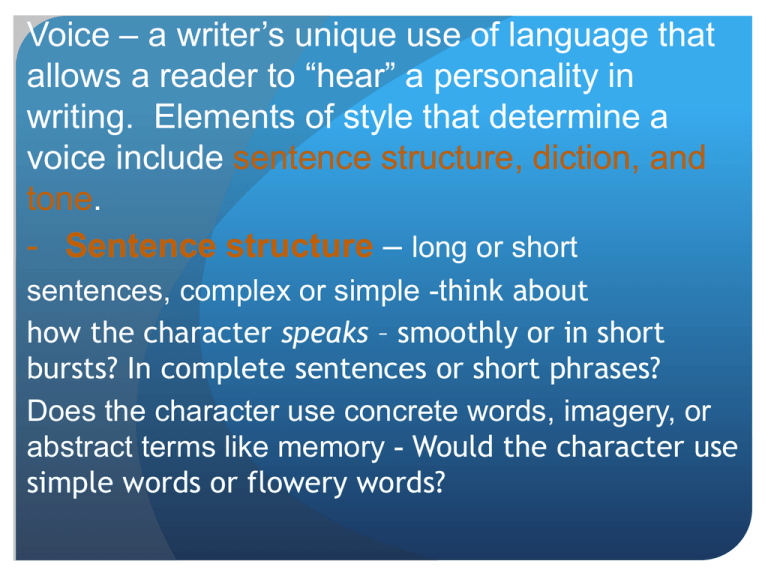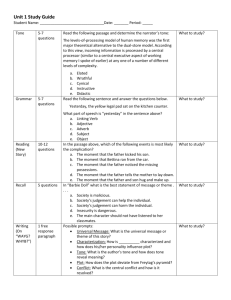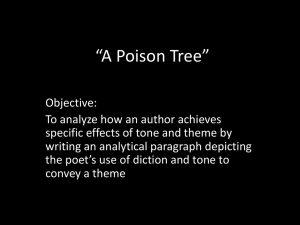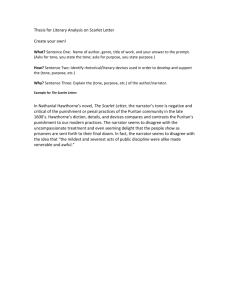Sentence structure
advertisement

Voice – a writer’s unique use of language that allows a reader to “hear” a personality in writing. Elements of style that determine a voice include sentence structure, diction, and tone. - Sentence structure – long or short sentences, complex or simple -think about how the character speaks – smoothly or in short bursts? In complete sentences or short phrases? Does the character use concrete words, imagery, or abstract terms like memory - Would the character use simple words or flowery words? Word choice – diction – the words the author chooses and the way he arranges words in sentences, ie. active or passive voice - think about how aligning a character’s words with thoughts, motivations, and experience to understand his/her voice; why is the author using specific words? If the writer’s purpose is to entertain, the reader will likely encounter words used in ironic, playful, or unexpected ways. A word’s power to produce a strong reaction in the reader lies mainly in its connotative meaning. Think about the connotation of: Mansion, abode, dwelling, domicile, residence, house, home, habitat, shack, shanty, apartment, chateau – how do these words convey different meanings? Tone - is the author’s attitude toward the topic. The tone, or attitude, of a piece of writing should be appropriate to the audience and purpose. The tone may be objective or subjective, logical or emotional, intimate or distant, serious or humorous. It can consist mostly of long, intricate sentences, of short, simple ones, or of something in between. Objective tone is impartial. It does not show any feelings for or against a topic; therefore, it is unbiased or neutral. Often objective tone uses higher level words and avoids pronouns such as I and you. (analytical essays) Subjective tone is personal, biased, emotional, and often informal. (narratives) You must notice how words and details are used within the writing. (con’t) Six different tones are used: optimistic, bitter, tolerant, sentimental, humorous, and objective. This place may be shabby, but since both of my children were born while we lived here, it has a special place in my heart. - The tone is sentimental. “…special place in my heart,” expresses tender emotions. This isn’t the greatest apartment in the world, but it’s not really that bad. - The tone is tolerant. The words “not really that bad” show that the writer accepts the situation while recognizing that it could be better. If only there were some decent jobs out there, I wouldn’t be reduced to living in this miserable dump. - The tone is bitter. The writer resents a situation that forces him to live in a “miserable dump.” This place does need some repairs, but I’m sure the landlord will be making improvements sometime soon. - The tone is optimistic. The writer is expecting the apartment to be improved soon. essay Each narrator of the Canterbury Tales has a different voice, though some may be similar. Write an essay that compares the Pardoner or Wife of Bath with the narrator of the tale that you presented in class. Explain how their voices differ and what role irony plays in both tales. HW: You will write an essay next week regarding the CT, so you will need to print out your tale. Please copy the document to a word document and format it so you are not wasting paper. Sentence structure paragraph 1 – 1 ex each long or short sentences, complex or simple -In complete sentences or short phrases? Does the character use concrete words, imagery, or abstract terms like memory Diction paragraph 2 – 1 ex each the words the author chooses and the way he arranges words in sentences - active or passive voice encounter words used in ironic, playful, or unexpected ways. A word’s power to produce a strong reaction in the reader lies mainly in its connotative meaning. Tone paragraph 3 – 1 ex each What is the tone? objective or subjective, logical or emotional, intimate or distant, serious or humorous notice how words and details are used within the writing – explain the connotation of words used! INCLUDE IRONY! The point is to explain how all of these elements get across the type of voice (personality) the narrator of each tale has. You should explain this in your conclusion. Tone words Positive – lighthearted, relaxed, amused, passionate, encouraging, soothing, romantic, optimistic, hopeful Negative – angry, insulting, arrogant, bitter, accusing, scornful, disgusted, critical, somber, serious, hopeless, regretful Neutral – formal, learned, reflective, factual, candid, detached, nostalgic, objective







